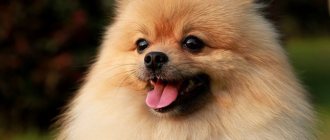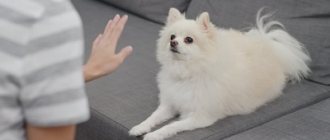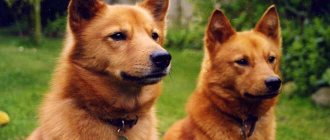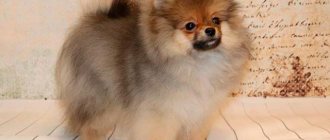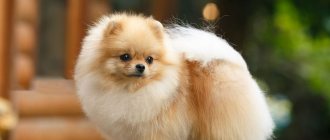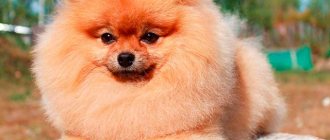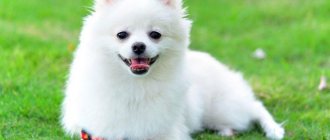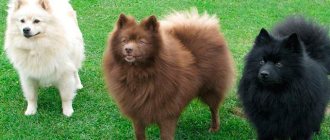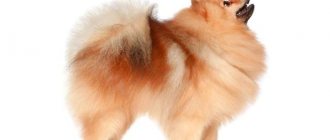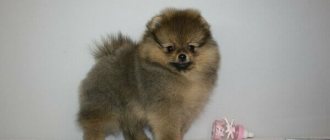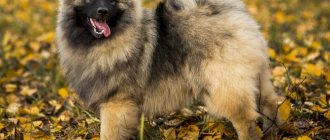History of the Pomeranian Spitz breed
Pomeranian Spitz puppy
Looking at the little ball curled up comfortably in a chair, it is difficult to imagine that his ancestors were several times larger and lived in the territory of modern Northern European countries. Archaeological burials of the Neolithic era serve as evidence of this. The so-called turf dogs were used for transportation due to their endurance and strength. It is worth noting that this method is still widespread in Iceland and Lapland. In the southern territories, these dogs were bred to guard ships in ports or property. The Middle Ages radically changed the attitude towards them: their pretty appearance and indomitable energy earned the love of the European aristocracy. Increasingly, noble ladies and august persons appeared at social events in the company of a four-legged companion.
Residents of Germany were the first to show sincere interest in the breed from which the Pomeranian spitz originated. It was here that Spitzhund dogs began to be bred, which by the 18th century had spread throughout the medieval state. For a long time, cynologists could not come to an agreement: where did the Pomeranian Spitz come from? The laurels passed either to the German city of Württemberg, the center of dog breeding, or to Pomerania, a Prussian province. Many experts have made bold statements comparing Spitz dogs to dogs that lived in China, Ancient Egypt and Greece. As a result, the right to be considered the birthplace of this breed was assigned to Pomerania.
The first individuals weighed about 15 kilograms and were larger than modern Pomeranians. Wanting to make the breed more compact, German dog breeders selected the smallest specimens for breeding. This business was continued in England, where the Pomeranian Spitz “sparkled” with new colors.
Queen Victoria played an important role in recognizing the breed. Like many before, she could not resist the charm of Marco, a Pomeranian who met the queen in Florence and soon went with her to England. Over time, this made the breed popular. Repeated victories of the Royal Spitz at various shows and exhibitions aroused the desire of the townspeople to acquire the same charming pets. At the end of the 19th century, the Pomeranian was recognized as a breed awarded a separate dog breeders club. It consisted mainly of noble ladies, many of whom later founded the first nurseries, where they bred and kept Pomeranian Spitz dogs, often of a certain color. For example, one of the nurseries was famous for animals with cream and white coats, while in another one could find specimens of black shades.
Trimmed Pomeranian Spitz
Pomeranian Spitz
The efforts of English dog breeders made it possible to change the size of the Pomeranian Spitz, which became significantly smaller in comparison with their German relatives. All animals were divided into two groups: individuals weighing less or more than seven pounds (about 3.1 kilograms). As a result of many years of selection, English Pomeranians became the standard that breeders from all over the world tried to meet. However, to this day the most miniature of the Spitz dogs are those from Pomerania.
Pomeranian Spitz white and two-tone colors
Back in 1892, this breed also conquered the inhabitants of America, where the dogs were brought from English kennels. Despite the fact that Pomeranians were not recognized by the American Kennel Club (AKC), a well-known canine organization that still exists, the animals were immediately loved for their enthusiasm, playful behavior and, of course, silky fur. Everything changed at the beginning of the 20th century, when the founding of the Pomeranian Club of America marked a milestone in the process of recognizing the breed.
Eleven years later, the first exhibition was held, where numerous Pomeranian breeders competed to become the best. By that time, Spitz could boast a whole palette of colors. Animals in black, white, chocolate, cream and blue shades aroused everyone's admiration, but only one Pomeranian received the highest award. It was Banner Prince Charming with wool of a noble black shade, which belonged to Mrs. F. Smith. Famous champions of subsequent exhibitions were the Pomeranian Spitz Dainty Might (Graceful Baby), Princess Ula and Twilight (Dusk). All of them gave birth to numerous offspring.
Pomeranian Spitz compared to humans
Despite the visible progress in the selection of Pomeranian Spitz, American dog breeders continued to work on improving the breed, but soon abandoned the attempt to make the animals more miniature. A strong decrease in body proportions led to the inability to procreate, which negatively affected the breeding of dogs. It was experimentally revealed that maintaining the blue color of Pomeranians is the most difficult, and white Spitz looked larger than their relatives with a different coat color and therefore participated less often in exhibitions.
It is worth noting that it was on the American continent that the correct name was assigned to the breed - Pomeranian. The rest mistakenly called the Spitz either German or dwarf. Nowadays this trend is less common, although in the FCI (International Canine Organization) classification Pomeranians are still registered under the name “German Spitz”.
This breed has come a long but interesting way from northern service dogs to the favorites of noble people. Now Pomeranians are regular participants in various exhibitions and events. Animals delight us with their intelligence, perky character and thick fur, inherited from their ancestors. Compact size combined with a big heart makes Pomeranians excellent companions and loyal friends.
Food allergies
For dogs with allergies, many manufacturers have produced hypoallergenic food.
A Spitz can be allergic to any product. This often happens when switching from natural to ready-made food or vice versa. But a product familiar to a dog’s diet can also become an allergen. The first symptoms are scratching of the pet, lacrimation, and stool disturbances. If they appear, the Spitz should be given an antihistamine and taken to a specialist. The veterinarian will be able to reliably determine the cause of the allergy and prescribe the correct treatment.
Appearance of a Pomeranian Spitz
The Pomeranian is a dwarf dog breed. However, his dense physique and strong muscles do not detract from his grace and grace. The FCI standard suggests that the height of a Spitz at the withers should be equal to the length of its body and be 18-22 cm.
The weight of oranges is proportional to their height and ranges from 1.5-3.2 kg. Exhibition representatives of the breed should ideally weigh 2 kg.
Head and skull
Walking Pomeranians
The head of the Pomeranian Spitz is small in size. The wide back of the skull tapers towards the nose, thereby forming a wedge. The rounded forehead contrasts with the insufficiently pronounced occipital protuberance. Cheekbones are practically invisible due to chubby cheeks.
Muzzle
A well-defined stop is a characteristic feature of the narrow muzzle, which is half the size of the skull. The small and neat nose is always black (may be brown in orange and red colored specimens). The situation is similar with lip color.
Ears
The triangles of the ears “stand” close to the top of the head. They have a sharp and hard tip. At birth, the Pomeranian's ears are droopy, but they "pick up" as the dog matures.
Eyes
White pug
Small dark eyes are set askew. The shape is mostly almond or oval. Eyelids black; dark brown pigmentation is acceptable in dogs of similar color. The Pomeranian has a lively and even mischievous look, which gives the animal a resemblance to a fox cub.
Jaws and teeth
The Pomeranian's upper jaw overlaps the lower jaw, thereby forming a regular scissor bite. Straight and pincer bites are not recognized as a defect. There are 42 teeth. The absence of premolars in the Pomeranian is not critical.
Neck
The strong neck has a slightly arched shape. The length is average, there is no so-called dewlap. The high waist is masked by a lush frill.
Pomeranian Spitz face
Frame
The Pomeranian's neck ends at the withers, and that ends at the short back. The loin, in turn, goes into a short, unsloping croup. The chest is developed. The abdomen should be tucked in and the ribs should be palpable.
Tail
Black Pomeranian Spitz
It has a medium length and is located relatively high. Due to the fact that the tail ring lies on the back, the dog looks miniature and round.
Forelegs
Set wide apart. The shoulders are distinguished by pronounced muscles. Tightly fitting fingers evoke associations with the neat paw of a cat. The black tint of the pads and claws is characteristic of all representatives of the breed, except red, cream and brown.
Hind limbs
Parallel to each other. The thighs and shins are in equal proportions. The small paws are not as round as the front paws. The toes are compressed and end in black claws and pads (brown in some dogs).
Movement style
The Pomeranian moves easily and flexibly. The hindquarters have good drive. The dog springs a little when walking.
Coat
The orange's fur hides a dense undercoat. Short soft hair covers the head, perky ears and the front side of the limbs. The remaining part of the body is distinguished by long, straight hair, which is not characterized by the presence of curls and waves. The dog's shoulders and fur are hidden by the mane. The fluffy tail blends smoothly with the “pants” on the hind legs.
Color
Little bear
The Pomeranian breed has ten coat colors: white, blue, black, cream, orange, sable, blue or black and tan, chocolate and two-tone. Spotted color implies white as a background color and an even distribution of markings.
A breed defect is any deviation from the standard. Among them:
- sharp narrowing of the skull from the back to the nose;
- the head is apple-shaped or too flat;
- watery, bulging eyes, their light shade;
- bodily pigmentation of the eyelids, nose and lips;
- waddling gait, “prancing”;
- double ring at the end of the tail;
- pronounced stop.
In addition, there are also disqualifying defects:
- aggressive or cowardly behavior;
- unhealed fontanel;
- half erect ears;
- undershot and/or undershot;
- eversion or inversion of the eyelids;
- clear boundaries of white spots.
In Pomeranian males, two developed testicles should be completely contained in the scrotum.
Mating, pregnancy, childbirth
The Pomeranian's first heat occurs between 8 and 12 months. It is impossible to knit a girl at this age, since the body is not yet fully formed.
Early pregnancy and childbirth are dangerous for the health of the pet and can result in the birth of non-viable offspring.
It is recommended to cross a Pomeranian bitch for the first time at about two years of age (on her third heat). The same rules apply to male dogs.
Spitz females can become pregnant after each heat, but this should not be allowed more than once every 1-1.5 years. Childbirth and breastfeeding exhaust the bitch's body and she needs time to fully recover.
A pair for mating is selected through a club or nursery. It is important that both dogs have a full package of documents, undergo the necessary tests for the presence of genetic diseases, vaccination and deworming procedures.
For your information! Female Pomeranians weighing less than 2 kg are excluded from breeding.
Pregnancy in the Pomeranian Spitz lasts from 58 to 64 days. Some individuals give birth on day 67 - this is also considered the norm. Puppies born before day 57 usually die. If labor does not occur longer than 70 days after mating, you need to contact a veterinarian - the pregnancy may be frozen. You cannot give your pet stimulants on your own! Such actions can lead to injury and uterine rupture. Such medications are used only by a doctor.
You need to be well prepared for the birth of your babies. Organize a comfortable “nest” for the bitch in which she can safely give birth. It is desirable that it consist of two sections. In one there will be newborn babies, in the other - a giving birth bitch.
About 7 days before giving birth, the female’s stomach drops, the vagina increases in size, and the back sags. The day before the puppies appear, the Spitz's body temperature drops to 37 degrees. The bitch becomes nervous, loses her appetite, and does not leave her owner’s side. She needs to be reassured, not left alone, and shown an organized place to give birth.
The process itself is usually easy for Pomovs and does not require emergency assistance. The first baby, when born, causes pain to the mother, the bitch may begin to whine. Other puppies are born less painfully.
Newborn puppies “come out” in the placenta. More often the bitch chews it herself. If this does not happen, the dog will have to help: grab the bubble with a clean gauze, tear it near the puppy’s muzzle, and remove it. You need to hold the baby upside down, clear the mouth and nose of mucous secretions, and blow into the face. If the puppy squeaks and starts spinning, then everything is fine. The umbilical cord must be cut with sterile scissors three centimeters from the tummy. You cannot tie it in a knot.
Little Pomeranians are born 15 to 30 minutes apart. After giving birth, the bitch should be given water with a small amount of honey (but not sugar). If she asks for food, you can give her some kefir or cottage cheese. You also need to provide her with a tray to relieve herself. When a female asks to go outside, she should be carried out in her arms and not allowed to walk around much. The vagina, tummy and anus should be treated with a slightly pinkish solution of potassium permanganate.
Pomeranians usually give birth to 1 to 3 puppies. To make the babies larger, a female is chosen weighing about 2.5-3 kg, a male - 500 g less. When mating a large bitch with a much smaller male, 4-6 Spitz dogs may be born, but they will be small and of different sizes. It is impossible to predict litter size in advance.
While nursing puppies, it is necessary to transfer the bitch to a special feeding diet for nursing mothers so that she has a sufficient amount of milk. Only in this case can you count on healthy offspring. If there is still not enough milk, it is recommended to supplement with a bitch milk substitute.
Photo of an adult Pomeranian Spitz
Toys
Pomeranians are big fans of entertainment and fun. Each dog has an individual character, so they like different toys. They come in several types. Some are intended for the street, for example, flying saucers, rings, so that the dog can run around to his heart's content.
Expert opinion
Anna Abramenko
An avid dog lover. Experience in veterinary medicine since 2009.
Ask a Question
It is worth noting that you should not let your Spitz chew sticks, as the wood chips can clog the stomach and damage it.
Other toys are used at home. They are divided into edible and inedible. The first type can not only entertain the Spitz, but also prevent the appearance of plaque and tartar on the teeth. Such toys are made from offal (ears, paws, legs), they are absolutely safe, and attract the dog with their taste and smell. The choice of inedible toys is much wider. They have different shapes and sizes. Most of all, Pomeranians love balls that can be bitten and chewed.
Expert opinion
Anna Abramenko
An avid dog lover. Experience in veterinary medicine since 2009.
Ask a Question
The owner should not buy a lot of toys. Dogs are not much different from children, so their abundance can lead to the fact that they all get bored quickly.
Character of the Pomeranian Spitz
Owners of charming Pomeranians note their good-natured character, unbridled curiosity and cheerful enthusiasm with which the fluffy buns explore the world even within the confines of an apartment. You should not get a Spitz as a decorative dog with whom you can lie on the couch and watch your favorite movie. The Pomeranian prefers active games, and a walk in the fresh air is a delight. A dog of this breed will happily fetch a thrown ball, chase a pigeon nestled on the curb and rush to protect its owner from the “threat”. In general, a fun walk with your fluffy fidget is guaranteed.
Spitz in a bicycle basket
The Pomeranian Spitz easily finds a common language with its owner, adapting to his lifestyle. A faithful dog will never make noise early in the morning if you prefer to get up around noon, and will follow on your heels as soon as you wake up. Representatives of this breed are attached to the family in which they live and can become sad if they are not given due attention. Many Spitz owners note that returning home after work is fraught with a remarkable show of love from the little bear. The dog will always be by your side: while cooking dinner, taking a shower and sleeping at night. Some animals can sleep in the room with their owner (sometimes next to them on the bed) in order to please them in the morning with another portion of affection and a loud call to take a walk in the city park.
The Pomeranian has a tendency to bark and responds with a booming “voice” to any suspicious rustle. This dog makes an excellent watchman who will scare away an uninvited guest, forgetting about his miniature size. Sometimes a Spitz may bark for no reason, and then the owner will have to gently correct his pet’s habit.
Spitz with his beloved owner
If you are planning to adopt a Pomeranian as a friend for your child, your attitude towards the new family member should be conscious and careful. Pomeranians will happily join children in a fun game if they are used to their company as a puppy. Otherwise, the dog will prefer to remain an outside observer.
The Pomeranian Spitz behaves reservedly with strangers and only in the absence of proper upbringing can it bark at a random passerby. The dog reacts warily to universal affection and not everyone will allow him to run his fingers through the soft plush fur.
The Spitz gets along well with other animals, but sometimes shows the habit of dominating its relatives. The appearance of a second dog in the house is an alarm bell for the Pomeranian: you need to show the owner and the new furry scoundrel who is boss in the house. However, if the Spitz grew up with other animals, these problems will not arise. Be careful when introducing your pet to decorative rats, hamsters, parrots and others: the Pomeranian's hunting instincts can appear at the most unexpected moment.
Purpose
This is a great companion dog, a sweet family pet. Some sources claim that the animals were previously used to catch rats. Even if they are really good rodent hunters, this ability is not relevant now. Now they serve as a favorite pet for residents of apartments and private houses.
Education and training
Training a Pomeranian Spitz
The Pomeranian Spitz is naturally gifted with highly developed intelligence, which greatly facilitates the learning process (compared to other decorative dog breeds). However, a stubborn and independent character can become a serious obstacle to following commands. Forget about traditional training methods: in this case they do not work. You will have to find a special approach to your pet.
The main thing in raising a Pomeranian is to forget about its touching appearance. Often, the owners of these dogs treat them like children, considering their pets small and not yet capable of carrying out complex commands. The Pomeranian Spitz needs a confident owner who can show strength of character and has leadership qualities. Only in this case does the dog willingly give in to training, learning both basic commands and tricks worthy of circus performances. If a Spitz considers himself a step above you, he will pointedly refuse to listen to any admonitions or requests to sit, lie down, or raise his voice.
Gentle handling of your pet and tasty rewards are the most effective approach to training this breed. The Pomeranian does not like criticism and responds to displays of cruelty or disrespect with willfulness, insolence, or even aggression. A disobedient dog will bring a lot of trouble to the owner, so first you need to teach your pet to perform the simplest actions: sit, lie, approach the leg, go to the place. The command to stop barking is no less useful: the high and ringing intonations of the “voice” will not appeal to everyone.
In general, dog breeders characterize the Pomeranian Spitz as a smart creature that is easy to train with the right approach to training. The only thing that may cause problems is toilet training. Due to the peculiarities of the Pomeranian’s structure, it is difficult for the Pomeranian to retain the contents of its bladder for a long enough time, so the dog can relieve itself right in the apartment. However, if you have the patience to teach your pet to ask for a walk on time, the cleanliness of your home will remain intact. Particularly creative dog breeders teach their Spitz to go to the cat litter box.
Tray training
Raising a clean dog is not that difficult. A tray for the puppy is arranged in the play area or near it. Primary training is organized using a diaper. Observing a German puppy, you can notice when he begins to look for a place to relieve his natural needs. Place a diaper where he sits. As soon as the Spitz performs the desired action, he is praised (petted). The diaper can be rinsed (but not washed), dried and placed approximately where it was used for its intended purpose.
Subsequently, when the puppy confidently uses the diaper, it is transferred to the tray. This way the “toilet” area will be moved and fixed. The tray is kept clean.
During walks, the dog is encouraged to eliminate. Gradually this will become a habit and the tray will lose its relevance.
All zones are organized not only taking into account the wishes of the Pomeranian, but to a greater extent respecting the interests of the owners. If it is undesirable for a dog to enter certain premises, you should simply block access to them from the very beginning of keeping it in the family. Pomeranians quickly get used to restrictions and take them for granted.
Care and maintenance
Long and fluffy hair is the main asset of Pomeranians, so the lion's share of care comes from careful combing. Representatives of this breed shed twice a year. In this case, the first shedding occurs in the fourth to sixth month, when the puppy’s down is replaced by “adult” fur. In Pomeranian Spitz bitches, shedding begins during estrus and after giving birth, so don’t be alarmed. However, constant bald spots should make you think about changing your pet’s diet and selecting new coat care products.
It is not recommended to bathe oranges more than once or twice a month (as needed). To do this, use diluted shampoo for long-haired breeds: a concentrated product may have the opposite effect. Be sure to condition the dog’s velvety fur with conditioner and dry it thoroughly with a hairdryer. Use a long-toothed comb or slicker brush. Please note that when combing the coat should be damp, so you should always have water softened with the same conditioner on hand. The molting period requires more thorough combing with a comb.
Thinning scissors are used to trim orange blossoms. Basically, the coat is shortened to maintain the dog's neat appearance. For hygienic purposes, Spitz owners trim the space between the paw pads and the area under the tail. Do not use the “machine” under any circumstances! This will disrupt the natural structure of the hair, which in the future can lead to the regular appearance of tangles in the hair.
Pomeranian teeth are brushed with a special paste 3-4 times a week. You can use a brush or attachment for this. A piece of bandage wrapped around your finger will also work. To avoid the appearance of tartar and further treatment, it is recommended to include solid food in your pet’s diet.
Nails are trimmed using a nail clipper for toy breeds. Don't forget to file away any sharp edges. The paw pads also deserve care: rub vegetable oil into them - and painful cracks will never bother your pet!
The orange's diet should be balanced. Dry food with the maximum content of essential minerals and vitamins is suitable for this. Natural food is no less healthy, but under no circumstances should you treat your Spitz to food from the table:
- sweets;
- milk;
- smoked meats;
- flour products;
- fatty and spicy foods;
- river fish.
Food should always be fresh and at room temperature. Do not forget about a sufficient amount of water, which needs to be changed daily.
The difference between a dog and a bitch
The main external and behavioral characteristics of the Pomeranian breed are inherent in individuals of both sexes, but there are still some differences between them. Thus, males are always the brighter representatives of the breed. Male poms are superior to females in appearance, have a more luxurious coat, and look better at shows. In addition, Spitz males shed less often and do not lose hair as much during seasonal shedding.
Males of this breed are more emotional and openly express their love and devotion to their owners. Males are less touchy, but more stubborn and cocky.
The main unpleasant aspects of keeping male Pomeranians are urine getting on the fur on the tummy and possible marks in the apartment. These points can be easily corrected by a suitable haircut, proper upbringing and timely walking of the pet. A properly cut Spitz does not have any unpleasant odors.
Another point is the “rut”. Even the most trained dog, having smelled a “dog wedding,” can become uncontrollable and run away from its owner.
Spitz females are very clean. Their long fur always looks neat, but they shed more. In addition to the seasonal change of hair, the female loses her undercoat before estrus, greatly “sheds” her hair after giving birth, then quickly grows back. During these periods, dogs require special care and enhanced nutrition.
By nature, Pomerantsev bitches are more cunning than males. They know how to find an approach to the strictest owner and know when to show tenderness. Females are more flexible and are not prone to escape.
Grooming
Pomeranian Spitz Health and Diseases
The Pomeranian's northern origin has given it good health compared to other dwarf breeds. Even in old age, these lively cubs feel great.
Pomeranian Spitz on a walk
The thick coat explains the oranges' predisposition to matting. Some dogs suffer from alopecia - baldness of certain areas of the body. The so-called black skin disease, which is fraught with complete hair loss and pigmentation of the skin, looks especially frightening. However, the disease itself does not harm the health of the Spitz, limiting itself only to the unattractive appearance of the animal.
Merle-colored Pomeranians are most susceptible to disease. They are born deaf, with increased intraocular pressure and coloboma - a defect in the lining of the eyes. There are disturbances in the functioning of the cardiovascular, musculoskeletal and nervous systems.
Typical diseases of Pomeranians include:
- ligament weakness;
- subluxation of the knee joint;
- dysbiosis of the gastrointestinal tract;
- colitis and gastritis;
- cough caused by spasm of the larynx;
- tearfulness;
- atrophy of the retina and tear duct;
- hypoglycemia;
- hydrocephalus.
Rare diseases include tumors and undescended testicles in male dogs.
Some important rules
Rules to follow:
- It is very useful to brush your Spitz's coat before bathing. This will allow you to achieve better washing results.
- The bottom of the bath is covered with a rubber or silicone mat to prevent paws from slipping and causing panic. The dog must stand steadily.
- It is advisable to carry out the first baths together: one owner holds and calms the dog, the second wets the fur and distributes shampoo, and receives the animal in a towel. This makes it possible to streamline the procedure and gradually teach the Pomeranian to tolerate it calmly.
- After wetting the wool, the detergent is applied from top to bottom, without circular soaping, gently massaging the coat. When choosing a shampoo, pay attention to the content of unnatural substances; preference is given to hypoallergenic formulations.
- The head is washed last, avoiding getting water into the ears and shampoo into the eyes. A damp atmosphere in the bathroom and without targeted washing will soften dried dirt in the ears and eyes; they can be easily removed with a cotton pad and pad.
- Do not wipe wet Spitz fur with a towel, but only blot it. You can change the towel and repeat the removal of moisture.
- It is not necessary to use a hairdryer in a warm, dry and clean room. Wool dries quickly naturally. If the temperature in the house is unstable, it is recommended to use a directed, non-hot and gentle stream of air (from bottom to top, from the stomach to the back).
Bathing softens dried dirt, eliminates odors, and unclogs skin pores. Pomeranians usually feel very good after a properly performed procedure.
How to choose a puppy
Before you take a new pet into your home, you need to decide on its future fate. Show-class puppies are the best suited for participation in exhibitions. Breed-class dogs are purchased mainly for breeding. If you see a Pomeranian Spitz as a wonderful friend and companion, pay attention to pet-class puppies - and you won’t go wrong.
The future dog owner must understand that there is no 100% guarantee. Not all representatives of the show class take pride of place at exhibitions, just as not all breeding class bitches are distinguished by their fertility. If this is important to you, it is better to get a Pomeranian from experienced breeders who pay due attention to proper dog breeding. Although we must not forget that even a pet-class baby can be raised into a champion if he fully complies with the breed standard.
When choosing a Pomeranian puppy, you need to pay attention to its health and appearance. A healthy baby should be lively, playful and high-spirited, show curiosity towards you and not be afraid of an outstretched hand. The size of the puppy should not determine your choice: even the smallest specimen can grow into a large dog.
The sex of the baby in most cases determines his behavior in the future. Males are distinguished by cockiness and stubbornness, while females are tender and flexible, although there are exceptions.
Difficulties in choosing
It is recommended to purchase a puppy at the age of two months. But if the choice fell on a white Spitz, choose dogs after six months. The color of puppies can change up to a year. Fawn babies sometimes turn white. Light red and smoky dogs can also change colors. White puppies often turn cream or gray after molting.
By the color of the fur behind the baby's ears, you can guess what color the Spitz will be. Japanese and American breeds were bred for their white coat; the color of these dogs will not change after molting. You shouldn’t take risks with other types of Spitz; it’s better to let the baby change his coat and leave it with the breeder for up to six months.
The cost of a white puppy does not differ from the price of representatives of other colors. Because after molting, no one can guarantee a snow-white coat without light spots and a uniform light undercoat.
The undercoat may change color after shedding
Spitz nurseries in major cities:
- "Mini Gum" (Moscow);
- "Bon Chanterelle" (St. Petersburg);
- “The Andreev Estate” (Eagle);
- Funny Honey (Kharkov);
- "Solar Joy" (Minsk).
Oh, these are such cool doggies! My friend has 2 puppies like this. Very tiny, just the size of a palm. They run and roll like teddy bears, like little bells. And how smart they are! Dan and Cherry. Everyone responds to their own name. When we walk with them, they do not leave each other. So wonderful. I want to constantly squeeze and caress them. And you can’t tell that these are dogs! Like toys! They get along well with cats. Very playful. And in their eyes you can always see loyalty and devotion!
Valeria, 12/01/2017
Photos of Pomeranian Spitz puppies
Prevention of parasites
All parasites that infect domestic animals are divided into two types:
- Internal - worms.
- External – fleas, ticks.
The best way to protect against these scourges is prevention. Combing the Spitz is carried out over a white cloth, so you can notice flea damage in time. This is also evidenced by the pet's constant scratching and hair loss. If an infection occurs, you need to buy special products in the form of drops, an aerosol or a collar from a veterinary pharmacy.
Ticks are dangerous parasites that carry serious diseases. During the season of their spread, the dog must be carefully examined after a walk, and drops must be used.
Prevention of worms is also necessary for the Spitz, because they greatly weaken the body. They fight their appearance with deworming three times a year. It is carried out not only on the Pomeranian, but simultaneously on all pets and people.
How much does a Pomeranian cost?
The price of a puppy depends on several factors.
Offspring from elite females and males cost from 50 to 100 thousand rubles. For 30-50 thousand you can take a Pomeranian from a more modest family. A furry baby without documents costs up to 15 thousand rubles. Remember that a female is valued several times more expensive than a male. It is best to buy a Pomeranian puppy from an official kennel that breeds this breed. This way you will get a faithful friend with excellent health and inexhaustible optimism.
Vaccination
Any breed needs timely vaccination; this is one of the main points of care.
Even small dogs are vaccinated according to age, regardless of the regularity of walking. A dog can catch the virus at home by licking shoes or the carpet in the hallway.
- at 2.5 months they are vaccinated against plague, hepatitis, enteritis;
- after 2 weeks, leptospirosis and parainfluenza are added;
- at 7 months – rabies.
All vaccinations are repeated every other year and annually.
Important! Before vaccination, oranges are cleared of fleas and helminths (2 weeks before). On the day of the procedure, the dog must be completely healthy, with normal body temperature.
